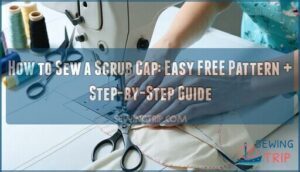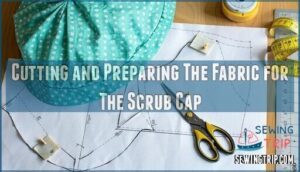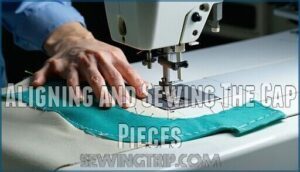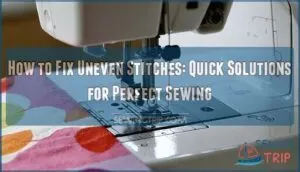This site is supported by our readers. We may earn a commission, at no cost to you, if you purchase through links.
 You’ll need cotton fabric, thread, scissors, and a sewing machine to learn how to sew a scrub cap that fits perfectly.
You’ll need cotton fabric, thread, scissors, and a sewing machine to learn how to sew a scrub cap that fits perfectly.
Start by cutting two main pieces and ties from your fabric using a free pattern. Sew darts for proper head shaping, then attach the pieces together with a curved seam.
Add ties to the back for secure fastening. The entire process takes about 45 minutes and creates a professional-grade cap that’s washable and comfortable for long shifts.
Your custom scrub cap will outperform store-bought versions in both fit and durability, plus there are clever shortcuts that make even hand-sewing possible.
Table Of Contents
- Key Takeaways
- Scrub Cap Sewing Tutorial: an Easy Step-by-Step Guide
- Supplies Needed for Sewing a Scrub Cap
- Downloading and Printing The Free Scrub Cap Pattern
- Cutting and Preparing The Fabric for The Scrub Cap
- Assembling The Scrub Cap
- Finishing Touches for The Scrub Cap
- Donating Your Handmade Scrub Caps to Local Hospitals
- Tips for Sewing Scrub Caps Without a Sewing Machine
- Other Scrub Cap Patterns and Variations
- Share Your Sewing Success and Inspire Others
- Frequently Asked Questions (FAQs)
- Conclusion
Key Takeaways
- You’ll need basic supplies – cotton fabric (2/3 yard total), thread, scissors, and a sewing machine to create professional-quality scrub caps that outperform store-bought versions.
- The process takes about 45 minutes – you’ll cut pattern pieces, sew darts for proper head shaping, attach pieces with curved seams, and add ties for secure fastening.
- Customization beats commercial options – you can choose your own fabrics, adjust sizing for a perfect fit, and create caps that are more durable and comfortable for long shifts.
- Hand-sewing is possible without a machine – using the backstitch technique, small even stitches, and proper needle selection, you can create strong, professional caps using only hand-sewing methods.
Scrub Cap Sewing Tutorial: an Easy Step-by-Step Guide
You’ll find sewing your own scrub cap surprisingly simple with our free pattern and clear instructions.
This tutorial walks you through every step, from cutting fabric to finishing touches, so you can create professional-quality caps that healthcare workers actually need.
Why Sew Your Own Scrub Cap?
Creating your own DIY scrub cap brings together cost savings and personal satisfaction in one rewarding project.
You’ll discover customization options that let you express your style while developing valuable sewing skills.
- Cost Savings – Homemade scrub caps cost less than store-bought versions
- Customization Options – Choose fabric choices that reflect your personality
- Skill Development – Master essential sewing techniques through practice
- Personal Satisfaction – Feel proud wearing your handcrafted creation
- Reusable Benefits – Create durable fabric scrub caps for long-term use
This scrub cap sewing project transforms basic materials into professional headwear that’s both functional and stylish.
Importance of Scrub Caps for Healthcare Workers
Healthcare workers wear scrub caps for infection control and hair containment during procedures.
Essential protection that keeps both patients and healthcare professionals safe during critical medical procedures.
These medical scrub caps prevent bacteria from spreading while maintaining professional appearance in operating rooms.
Nurse scrub caps offer comfort during long shifts and guarantee regulatory compliance with hospital standards.
Scrub caps are essential because they help maintain sterility in the OR.
| Primary Benefits | Impact on Patient Care |
|---|---|
| Infection Control | Reduces surgical site infections |
| Hair Containment | Prevents contamination during procedures |
| Professional Standards | Builds patient confidence and trust |
Supplies Needed for Sewing a Scrub Cap
Before diving into scrub cap sewing, gather your essential sewing supplies to guarantee success.
Quality materials make all the difference in creating durable, comfortable caps for healthcare workers.
- Fabric Types: Choose tightly woven, 100% cotton quilting fabric (1/3 yard each for main and lining)
- Sewing machine: Basic model works fine with a sharp, new needle installed
- Thread Choices: All-purpose polyester thread matching your fabric color
- Sharp fabric scissors: Invest in quality shears for clean, precise cuts
- Pins: Essential for holding pattern pieces and fabric layers securely
- Iron: Steam setting helps press seams flat for professional results
- Elastic Options: 1/4-inch elastic (3 inches) for adjustable fit
- Button Selection: Two small buttons (optional) to reduce ear pressure
Having proper sewing supplies ready streamlines your scrub cap project and guarantees professional-looking results.
Selecting the right fabric material is key for comfort and durability.
Downloading and Printing The Free Scrub Cap Pattern
Now that you’ve gathered your materials, it’s time to get your hands on the free PDF pattern. Start by downloading the printable pattern from a trusted hospital or sewing website.
This surgical cap pattern comes as a multi-page document that you’ll need to handle carefully. Before hitting print, double-check your printer settings.
Set them to "Actual Size" or "Custom Scaling: 100%" – this step is critical for pattern accuracy. Never use "Fit to Page" because it’ll throw off your measurements completely.
Print on standard US letter paper size for best results. Once printed, you’ll see registration marks and alignment guides on each page.
These little circles and lines aren’t just decoration – they’re your roadmap for assembling pages correctly. Trim the excess paper around each piece, but don’t cut into the actual pattern lines.
Now comes the fun part: assembling pages like a puzzle. Line up those registration marks perfectly and tape the pieces together. Take your time here – proper pattern scaling depends on accurate assembly for your scrub cap sewing success.
Many sewers also look for a printable scrub pattern to complete matching sets.
Cutting and Preparing The Fabric for The Scrub Cap
Once you’ve printed and assembled your pattern, it’s time to cut your fabric pieces with precision and accuracy.
This step sets the foundation for a well-fitted scrub cap that’ll serve healthcare workers reliably.
Transferring Markings and Darts
Now that you’ve cut your fabric pieces, it’s time to get those pattern details onto your material. Accurate transfer makes all the difference between a professional-looking scrub cap and one that looks homemade.
Here’s what you’ll need for perfect markings:
- Marking tools like a washable marker or fabric chalk for clear, removable lines
- Sharp scissors to create precise notch cuts without fraying edges
- Pattern weights or pins to keep your template steady during transfer
- Good lighting so you can see every detail clearly
Start by placing your pattern on the fabric’s wrong side. Use your washable marker to trace around each dart placement point. Don’t skip the notch marks – these little triangular cuts help you align pieces perfectly later.
Understanding darts shape fabric for a better fit. Clip each notch about 1/8 inch deep into the seam allowance. Take your time here because accurate transfer saves headaches during assembly.
Sewing Darts for a Better Fit
Now you’ll pin and sew those darts for a custom fit. Position each dart precisely at your markings, matching the angles perfectly.
Sew from the wide end toward the point, backstitch at the start, then taper to nothing at the tip. Sewing darts tutorial can provide additional guidance.
Press darts toward the center back for cotton fabrics, creating that professional shape your scrub cap needs to achieve a perfect look.
Assembling The Scrub Cap
Now you’re ready to bring your scrub cap to life by joining the pieces together.
This step transforms your cut fabric into a functional cap that’ll provide comfort and protection for healthcare workers.
Aligning and Sewing The Cap Pieces
Aligning your curved pattern pieces requires steady hands and careful attention to fabric design alignment.
Pin the curved edges together, matching notches and ensuring your seam allowance consistency stays at 1/4 inch.
Use stitching speed control on your sewing machine for curved seam precision.
Backstitch at the beginning and end to secure your work.
Consider edge finishing options like zigzag stitching to prevent fraying during laundering.
Attaching Ties to The Scrub Cap
Tie placement makes or breaks your surgical cap’s comfort and functionality.
Position ties at the marked spots on each side piece, aligning raw edges precisely.
Use your sewing machine to attach with a 3/8" seam allowance, backstitching for knot security.
Consider tie length based on hair volume—longer ties accommodate ponytails better.
Quality fabric choice guarantees durability through repeated washing.
For alternative closures, substitute elastic bands following the same sewing tutorial principles.
Finishing Touches for The Scrub Cap
Your scrub cap is nearly complete, but these final details make all the difference.
Start with seam reinforcement by adding a topstitch along the curved seam where the cap top meets the sides.
This extra stitching prevents stress tears during frequent washing.
For elastic options, thread a 3-inch piece of quarter-inch elastic through the casing you created earlier.
This gives healthcare workers a snug, secure fit.
Test the tension before securing the elastic ends.
Consider button placement if you’re adding ear-saver buttons.
Position them about an inch from each tie end, ensuring they’re sewn securely through all fabric layers.
Raw edge enclosure is critical for durability.
Check that all seam finishing is complete, whether you’ve used serged edges or zigzag stitching.
Any exposed raw edges will fray quickly in hospital laundry.
For fabric embellishments, keep decorations minimal and washable.
Healthcare facilities prefer simple, professional designs.
Donating Your Handmade Scrub Caps to Local Hospitals
Successfully donating your handmade scrub caps requires understanding hospital needs and following proper donation guidelines.
Most hospitals have specific fabric standards requiring 100% cotton materials that withstand high-temperature washing for sterilization.
Contact your local hospital’s volunteer coordinator first to discuss their current needs and color requirements.
Many facilities prefer solid colors or simple patterns to maintain professional appearance.
Package your caps in clean bags with quantity labels.
Some hospitals offer delivery options including drop-off locations or scheduled collection events.
Your scrub cap sewing efforts directly support healthcare workers facing equipment shortages.
Community sewing efforts strengthen hospital-community relationships while providing comfort to medical staff during long shifts.
Local hospital support through handmade donations boosts morale and shows appreciation for their service.
Because scrubs need to be durable, polyester blends offer longevity.
Consider organizing recognition efforts to acknowledge fellow sewers and encourage continued participation in these meaningful community projects.
Tips for Sewing Scrub Caps Without a Sewing Machine
Without skipping a beat after donating your handmade scrub caps, you can still create effective surgical cap patterns using hand-sewing techniques. Sharp needles (size 7-9) and quality thread guarantee stitch strength that rivals machine work. Your fabric choices should include tightly woven cotton for durability.
For those looking to contribute, consider following a DIY surgical cap tutorial.
- Backstitch technique provides strongest hand-sewn seams for your DIY scrub cap sewing
- Small, even stitches (1/8" apart) create professional-looking seam finishes
- Whipstitch raw edges to prevent fraying and extend cap lifespan
- Extra pins on curves maintain alignment during challenging hand stitching sections
- Finger pressing seams sets stitches without needing an iron
This sewing tutorial proves that needle selection and proper hand stitching techniques create durable, professional caps.
Other Scrub Cap Patterns and Variations
Once you’ve mastered the basic scrub cap, you’ll discover there’s a whole world of styles to explore that cater to different hair types and personal preferences.
From bouffant caps that accommodate voluminous hair to ponytail-friendly designs with convenient openings, these variations let you customize your headwear for maximum comfort and functionality.
Bouffant Cap Pattern
If you’re looking for roomier coverage, the bouffant scrub cap pattern delivers exceptional volume control for thick or long hair.
This free PDF pattern uses pleats along the curved edge to create generous space while maintaining a professional appearance.
Fabric choices like quilting cotton work beautifully, and you can customize with elastic options at the back for secure fit.
Pattern modifications allow sizing adjustments from standard to extra-large, and the sewing tutorial guides you through creating the signature gathered crown that makes this bouffant style so practical for healthcare workers needing maximum hair containment.
Tie Back Cap Pattern
Tieback caps feature adjustable ties that let you customize the fit perfectly for your head size and hair volume.
You’ll love how the long fabric ties at the back create a secure fit without elastic discomfort.
This sewing pattern includes a flat top crown with a double fabric layer at the forehead for extra sweat absorption.
The lightweight design works beautifully for both short and long hair styles.
When choosing fabric choices, stick with 100% cotton for breathability and comfort level during those marathon shifts.
Pattern customization is simple since you can adjust tie length based on your preferences.
Reversible Surgical Scrub Cap Pattern
Reversible surgical scrub caps double your style options with smart fabric combinations. You’ll love switching between coordinating prints or bold contrasting colors to match different scrubs throughout your week.
- Fabric Combinations: Mix cotton prints with solid colors for professional versatility
- Pattern Modifications: Use the same base sewing pattern with adjusted seam allowances for durability
- Layering Techniques: Construct two cap bodies together, then turn right-side out for clean edges
This reusable scrub cap design offers reversibility benefits that extend your wardrobe without extra storage space. Understanding fabric grain guarantees accurate alignment during the sewing process. The surgical cap maintains comfort while providing style options that keep you looking fresh during long shifts.
Ponytail Scrub Cap Pattern
If you need extra room for long hair, ponytail variations offer the perfect solution. These scrub cap patterns include an integrated pouch that keeps your ponytail secure while maintaining professional comfort.
The ponytail scrub cap design eliminates the hassle of constantly adjusting ties. You’ll appreciate how the elastic band provides consistent tension without creating pressure points. Sizing adjustments are simple—just modify the elastic length.
Comfort features like moisture-wicking fabrics make long shifts bearable. This sewing pattern works beautifully with cotton prints that match your scrubs or reflect your personality.
| Feature | Benefit | Why It Matters |
|---|---|---|
| Elastic placement at neck | Hands-free adjustment | No retying during shifts |
| Ponytail opening | Hair stays contained | Meets hygiene standards |
| Fabric choices | Personal expression | Boosts workplace morale |
The elastic band provides consistent tension without creating pressure points, and the integrated pouch keeps your ponytail secure. These features combined make the ponytail scrub cap a practical choice for individuals with long hair.
Share Your Sewing Success and Inspire Others
Now that you’ve explored different scrub cap styles, it’s time to celebrate your accomplishments and motivate others to join this meaningful mission. Share photos of your finished scrub caps on social media using hashtags like #ScrubCapSewing and #DIYHealthcareSupport.
Document your cap donations by photographing healthcare workers receiving your handmade gifts—their smiles tell powerful sewing stories that inspire community support. Include pattern feedback in your posts, mentioning which techniques worked best and any success tips you discovered.
Maybe you found that pre-washing fabric prevented puckering, or that using contrasting thread made topstitching easier. These practical insights help fellow sewers avoid common pitfalls. Tag local hospitals and healthcare facilities when sharing your community impact.
Your posts create a ripple effect, encouraging neighbors to start their own scrub cap projects. When crafters see real healthcare workers wearing handmade caps, they understand how DIY efforts directly support frontline heroes. Your sewing journey becomes a beacon that lights the way for others seeking to serve their community through meaningful handwork.
Frequently Asked Questions (FAQs)
How much fabric do I need to sew a scrub cap?
You’ll need approximately 2/3 yard of quilting cotton total: 1/3 yard for the main fabric and 1/3 yard for lining.
This gives you enough material for one adult scrub cap with room for cutting adjustments.
What is the difference between a scrub cap and a surgical cap?
There’s no real difference between scrub caps and surgical caps – they’re the same thing.
You’ll find both terms used interchangeably in hospitals and medical settings.
They protect hair during procedures, which can be considered a complete concept in medical attire.
What fabric to use for scrub caps?
Like choosing the right thread for a strong seam, you’ll want 100% cotton quilting fabric for your scrub caps.
Pre-wash tightly woven cotton to prevent shrinkage and guarantee breathability for comfortable wear.
How often should scrub caps be washed?
You should wash scrub caps after every shift to maintain hygiene and prevent contamination.
Daily washing removes bacteria, sweat, and potential pathogens that accumulate during your workday, keeping you and your patients safe, which is crucial for maintaining hygiene.
Can synthetic fabrics be used instead?
You can use synthetic fabrics, but they’re not recommended for scrub caps.
Cotton’s breathability and comfort make it the preferred choice for healthcare settings where you’ll wear caps for extended periods.
Whats the best stitch for reinforcement?
Backstitching creates the strongest reinforcement for scrub cap seams.
You’ll want to backstitch at the beginning and end of each seam, especially where ties attach to the cap body, since these areas face the most stress during wear.
How to adjust cap size properly?
Perfect fit is like tailoring a suit – small adjustments make all the difference.
You’ll lengthen or shorten ties by 1-2 inches, adjust elastic tension, or add/remove fabric width at seams for comfort.
Are there left-handed cutting considerations?
Left-handed sewers benefit from reversing cutting direction and using specialized scissors designed for their grip.
Position patterns with cutting lines facing you, and cut counterclockwise around curves for better control and visibility.
Conclusion
Like a master tailor crafting a perfect fit, learning how to sew a scrub cap transforms raw fabric into professional protection.
You’ve now mastered every step from cutting patterns to sewing curved seams and attaching ties.
Your handmade cap won’t just fit better than store-bought versions—it’ll last longer too.
With practice, you’ll create multiple caps quickly for yourself or donation.
Start your next project today and experience the satisfaction of wearing something you’ve skillfully crafted.















